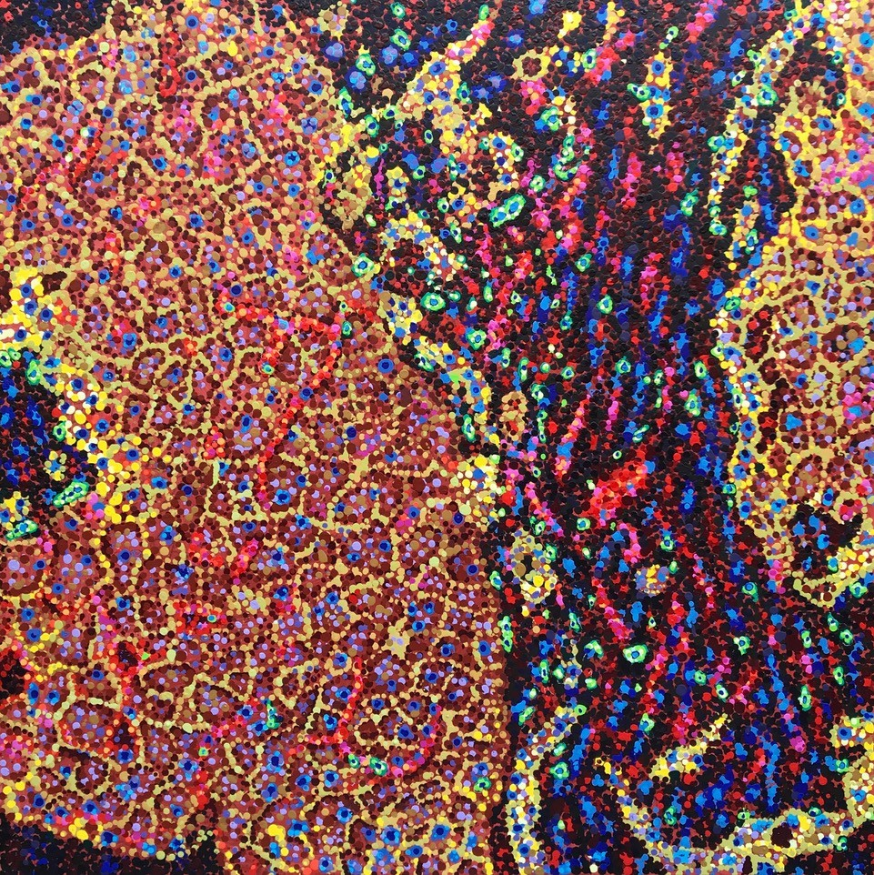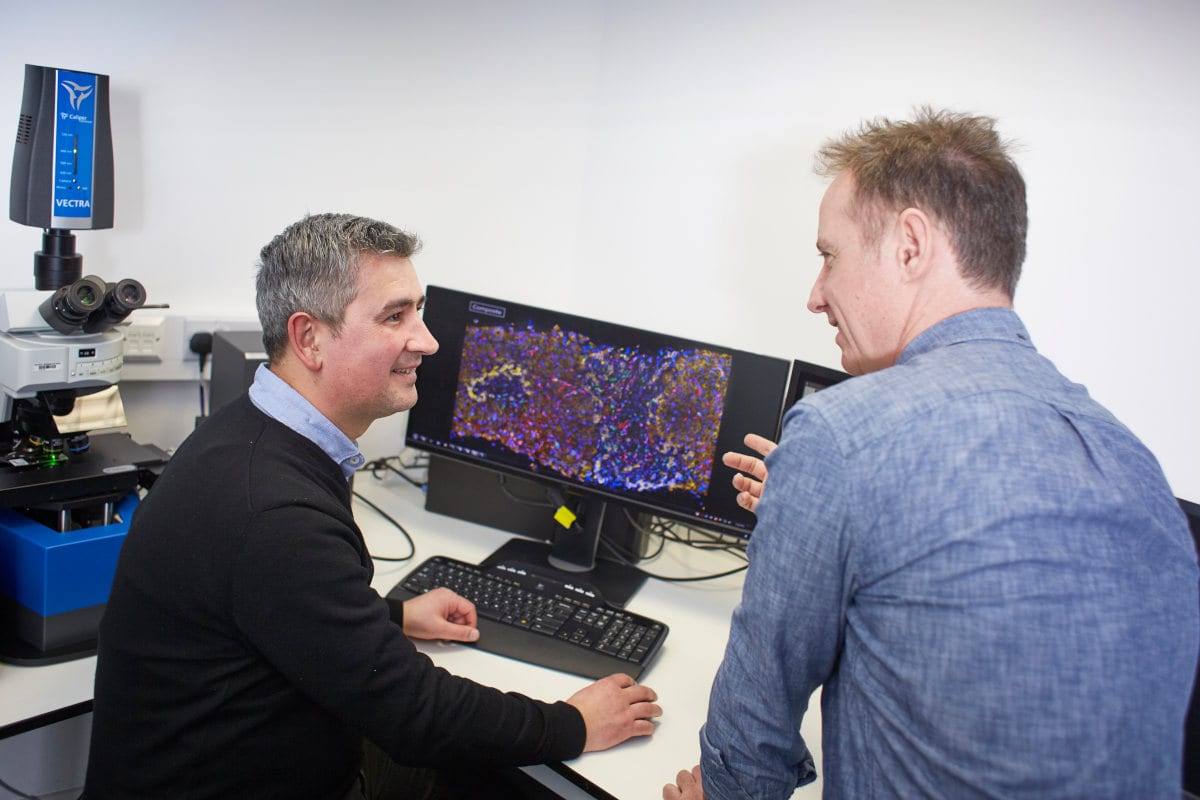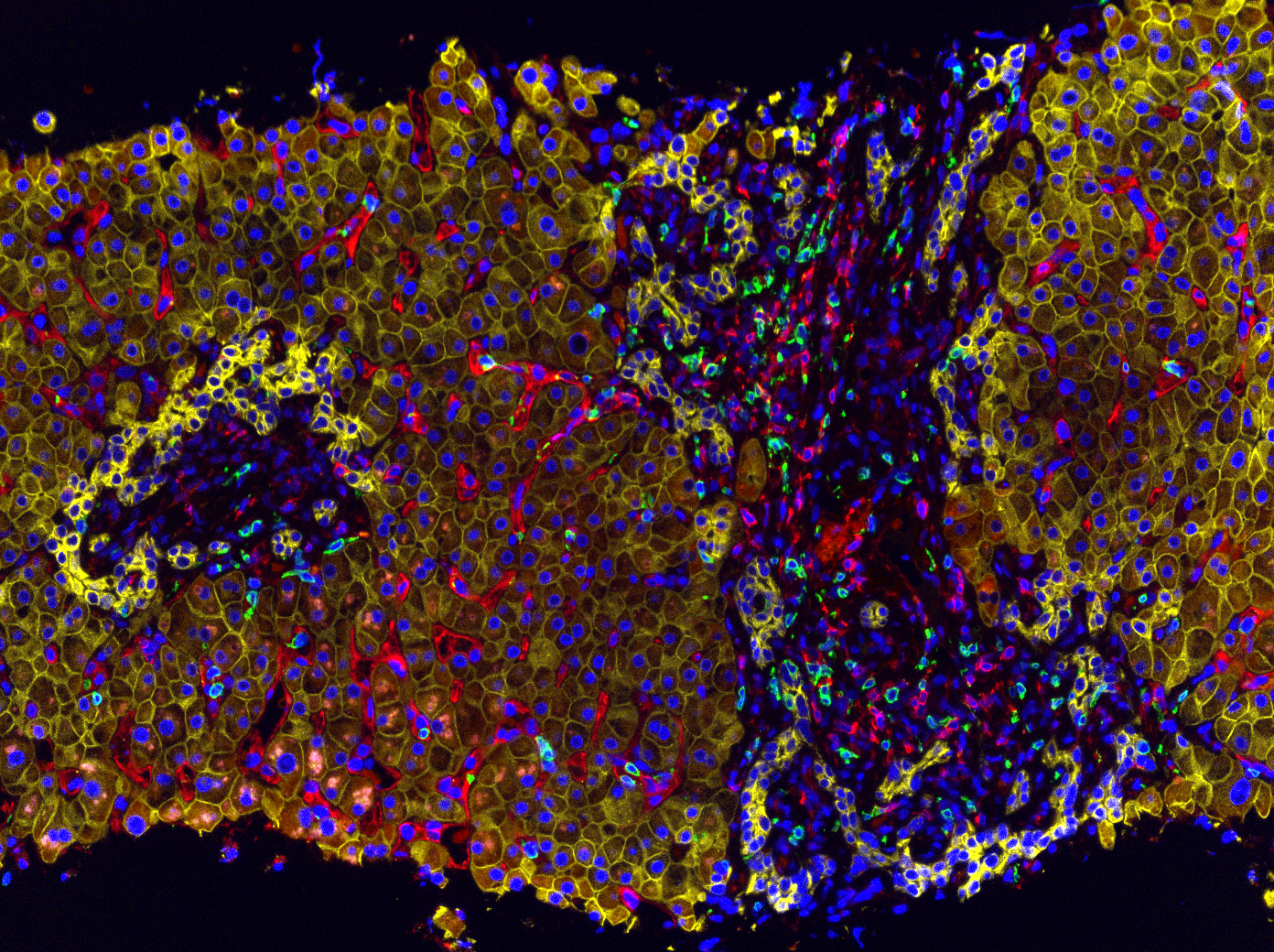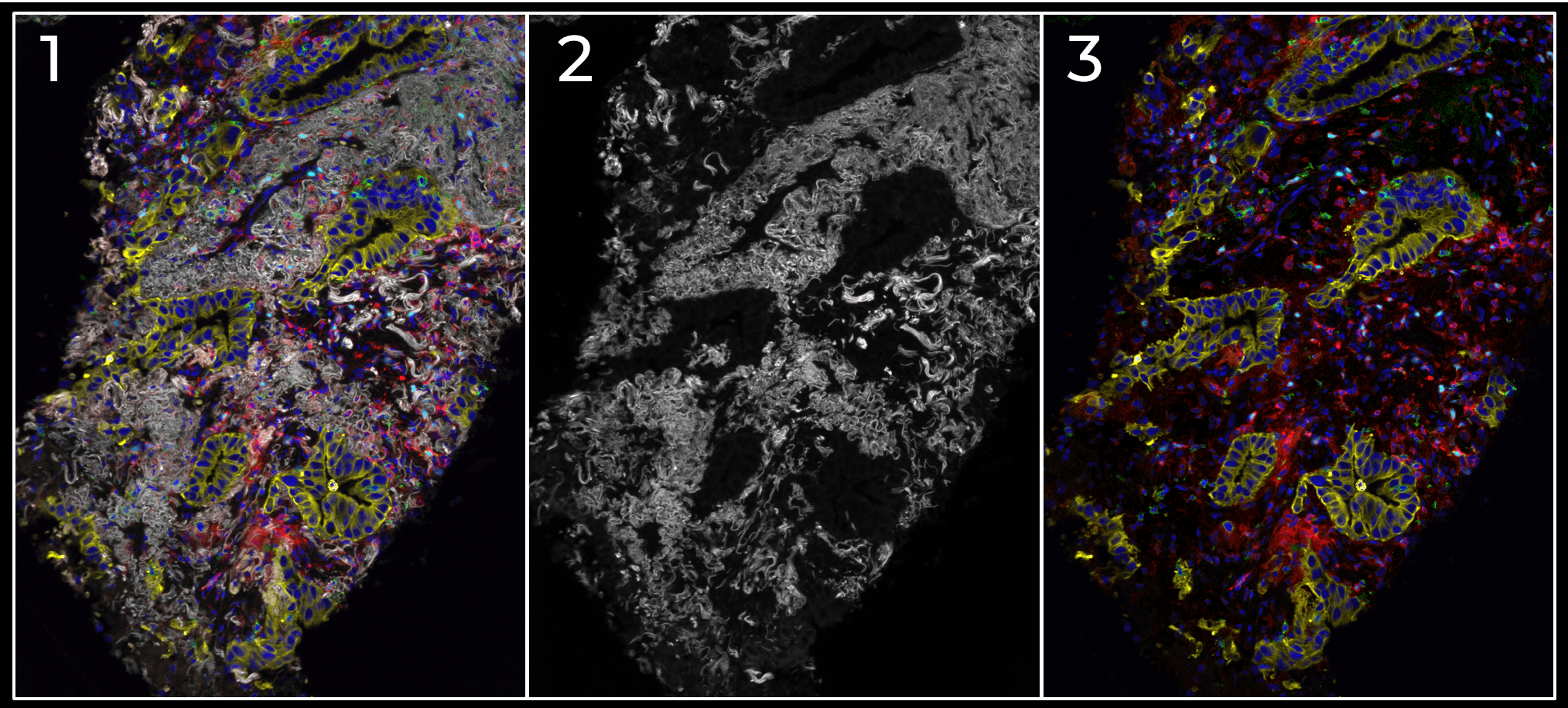To support fund-raising initiatives for its new Centre for Cancer Drug Discovery, the Institute of Cancer Research worked with street artist James Cochran to create an extraordinary piece of art using a laboratory pipette. Titled “Cell Defence”, the artwork was inspired by an image from the Cancer Biomarkers team at the ICR that visualizes tumour infiltrating T-cells in a liver biopsy from a patient with cholangiocarcinoma – an aggressive cancer of the bile duct. “Cell Defence” really is a perfect example of where science meets art.
As technologies from our Phenoptics™ workflow were used to create the inspiring image, we were curious to learn more about how the ‘Cell Defence’ project evolved. We spoke to both Mateus Crespo, from the Cancer Biomarkers team at the ICR, who created the image using Vectra® 3 automated quantitative pathology imaging system and inForm® software, as well as the artist James Cochran. In describing the work of their lab team, Mateus highlighted how multispectral imaging supports their critical research into understanding the development and progression of cancer. James went into further detail about the art project and what it symbolizes for the cancer research community.
The painting ‘Cell Defence’ is taking pride of place in the ICR’s new Centre for Cancer Drug Discovery. Can you tell us more about this new facility and how it will further support cancer research?
Mateus: I remember hearing about this project many years back when it was only an idea, and for the past 2 years it has been extremely gratifying to witness the rapid evolution of the construction of such a fantastic building. We can finally be proud to say that the ICR has now officially opened its doors to the Centre for Cancer Drug Discovery located on the Sutton campus.
The building itself is a state-of-the-art hub accommodating 21 research teams in cancer therapeutics and evolutionary science and will host the world’s first ‘Darwinian’ drug discovery programme, focused on overcoming cancer evolution and drug resistance.
One of the biggest challenges in cancer therapy today is the cancer’s ability to adapt, evolve and develop resistance to existing therapies. The research that this Centre will facilitate is going to make a huge positive impact to people with cancer, by creating a single collaborative space where around 300 of our leading scientists – from Cancer to Evolutionary Biologists, Chemists, Big Data Specialists and Clinician Scientists – will develop entirely new targeted and ‘smarter’ cancer therapies that can delay or block the process of resistance and manage more efficiently long-term advanced disease. In effect, this state-of-the-art facility will help our scientists to make the cancer treatments of the future.
The image that inspired the artist James Cochran to create ‘Cell Defence’ was produced by the Cancer Biomarkers Team. Can you tell us more about your group and your research goals?
Mateus: The Cancer Biomarkers team, led by Professor Johann de Bono, is a multidisciplinary team focused on developing new cancer treatments and deciphering the biology of multiple cancer types, and particularly focused on prostate cancer research. Here, Nurses, Radiologists, Oncologists, Clinical Trial Coordinators, Data Managers, Biologists, Clinicians, Pathologists, Biomedical Scientists, Statisticians and Bioinformaticians, are fully committed to accelerating anticancer drug development and are currently evaluating over 50 novel anticancer drugs. Our group focuses on developing novel targeted therapeutics for the treatment of patients with advanced disease, particularly those with metastatic castration resistant prostate cancer. Hundreds of patients are evaluated for early clinical trials each year at The Royal Marsden hospital, with many of these patients being recruited to trials of several targeted agents. We have tested numerous of novel agents, successfully developing multiple prostate cancer treatments such as abiraterone, cabazitaxel, enzalutamide, olaparib, ipatasertib, which are routinely used in the clinic around the world. We have also led on the first molecular stratification of advanced prostate cancer.
Moreover, in order to study mechanisms of tumour progression and resistance to current therapies, our group together with the Prostate Targeted Therapy Group at The Royal Marsden hospital and Drug Development Unit, have been successfully collecting serial tumour biopsies from patients with a broad range of malignancies. These samples are then studied through a multitude of techniques carried out in our lab, including next generation sequencing, immunohistochemistry, multiplex immunofluorescence, RNAish, fluorescent in situ hybridization, among many others. Finally, we have also evaluated the prognostic value of ‘liquid biopsies’ namely circulating tumour DNA and circulating tumour cells as well as their utility for pharmacodynamic studies of targeted agents.
The image that inspired “Cell Defence”. Credit: Mateus Crespo, Dr. Bora Gurel, Ana Ferreira, Rita Pereira and Prof. Johann de Bono, The Institute of Cancer Research.
Description: Liver biopsy from a patient with cholangiocarcinoma – an aggressive cancer of the bile duct – showing liver cells (yellow) being infiltrated by immune cells (red – T-helper cells; green – T-cytotoxic cells).
Multispectral technology has been key to obtain improved quality images that help us to better visualize tumours and the cells surrounding them.
Multiplexed staining and spectral unmixing techniques were essential to create the image. How is this technology important for your research?
Mateus: The Vectra microscope has been a fundamental tool in our group and cancer research for the last 8 years. Both Vectra with its multispectral technology and digital pathology software inForm have allowed us to implement comprehensive multiplexed immunofluorescence panels focused on studying tumour infiltrating leukocytes and to elucidate on their role in tumour immune evasion. These immunofluorescence studies have been particularly important in a broad range of clinical trials. A big bonus of using this technology is its capability of removing ‘background fluorescence’, also called autofluorescence, which was previously a problem for imaging certain types of tumour biopsies. Overall, multispectral technology has been key to obtain improved quality images that help us to better visualize tumours and the cells surrounding them.
Credit: Mateus Crespo, Dr. Bora Gurel, Ana Ferreira, Dr. Juanita Lopez, Dr. Anna Minchom, Prof. Udai Banerji and Prof. Johann de Bono, The Institute of Cancer Research.
Description: Lung biopsy from a patient with non-small cell lung cancer. Multispectral removal of autofluorescence (white) reveals otherwise hidden T-lymphocytes (red – T-helper cells; green – T-cytotoxic cells and cyan – T-regulatory cells) surrounding and infiltrating the cancer (yellow).
1- Vectra original multiplex immunofluorescence image
2- Tissue autofluorescence isolated using multispectral imaging technology
3- Enhanced image after autofluorescence removal
“Cell Defence” is a thought provoking cell portrait symbolising the complexity of the cancer biology and how researchers from different disciplines need to come together to defeat cancer.
How have scientists and researchers at the ICR responded to ‘Cell Defence’? What feedback have you received?
Mateus: The rapid progress of the Centre for Cancer Drug Discovery building was only made possible by the generous support of funders and donors, as well as successful fundraising appeals such as the ‘Let’s finish it’ appeal. The ‘Cell Defence pipette painting’ was one of the public relations campaigns which helped drive fundraising success.
‘Cell Defence’ was shared by the ICR across various platforms with researchers and the public. The artwork is on permanent display at the new Centre for Cancer Drug Discovery and will hopefully inspire researchers for generations to come.
As a scientist who works with visual images on a daily basis, I believe James’ work is both an artistic and technical feat. It is literally made up of hundreds of individual pipette-painted dots; and it is also a thought provoking “cell portrait” symbolising the complexity of the cancer biology and how researchers from different disciplines need to come together to defeat cancer.
‘Cell Defence’ is a perfect example of where science meets art. How did this project differ from others you have undertaken?
James: I normally work in a ‘pointillist’ style, making images from dots with a spray can, so this was quite a different approach with a lot of precision involved to make the painting. I was using a tool I had never used, the laboratory pipette, and the paint had to be mixed in a very specific way in order for this to work. I spent a lot of time mixing up the colours and finding the right consistency for the paint. After that it was the process of layering hundreds of blobs of paint to construct the image.
You selected the image from an internal competition run by the ICR. What was it about this image that inspired you to choose this for the commission?
James: There is certainly a beauty in these images despite what they might be depicting and the first thing that struck me was luminous colour and geometry of the cells that reminded me of a stain glass window. Capturing that luminosity of light and colour was always going to be the main challenge for me. The second important aspect was what the image was depicting and I wanted a positive or healing element to the painting, which is why I chose this particular image because it depicts T-cells from the immune system moving in to attack cancerous cells. In this way I wanted the painting to have a positive effect on both levels, scientifically for what it was depicting, and artistically through the use of colour.
In your view, what does the painting symbolize for cancer research?
James: I think the painting could symbolise the intersection of rigorous science and a creative approach to find new treatments to end cancer.
Learn more about “Cell Defence” at the new Centre for Cancer Drug Discovery.









